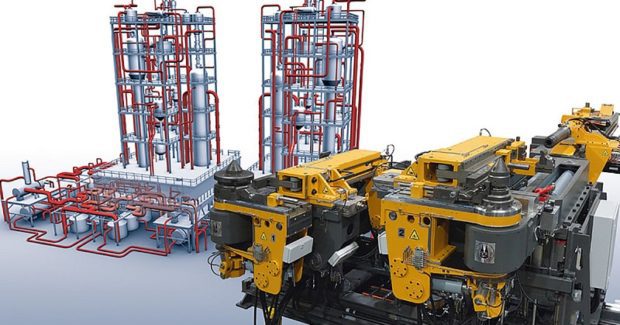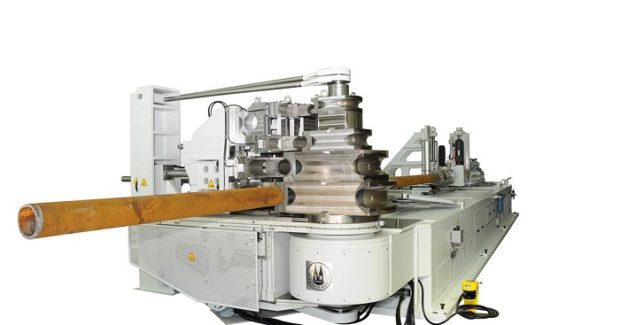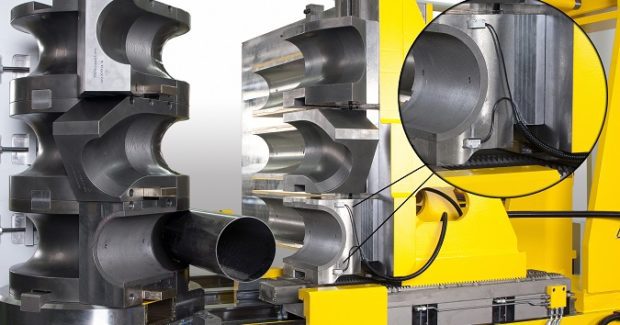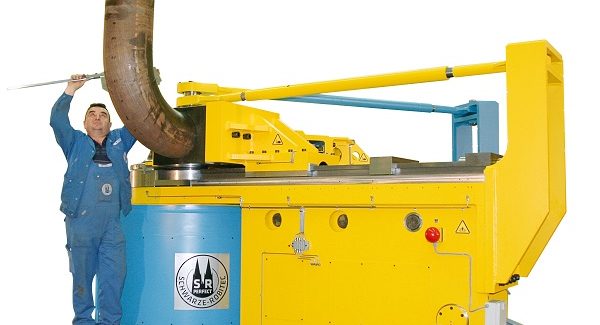Making Fabrication More Efficient in Power Plant Construction
During construction, miles of pipelines are fabricated from a variety of materials with variable diameters and nominal widths. To save time and reduce costs, automated CNC tube bending machines can bend, measure and adjust 3D pipe systems in a single operation – without welding – with a measuring system integrated into the bending tool.
Posted: February 10, 2018
Power plant construction begins with site preparation, drainage, installation of underground utilities, and structural steel and other construction of buildings on the site. Mechanical equipment installations include boilers, flue gas desulfurization scrubbers, cooling towers, steam turbine generators, condensers, photovoltaic modules, combustion turbines, and other auxiliary equipment. Electrical equipment, instrumentation and control installations include electrical transformers, switchgear, motor control centers, switchyards, distributed control systems, and other electrical commodities. In the midst of all this construction are many miles of pipe and long stretches of pipeline used in large power plant operations. Pipe fitting plays a special role in both plant and pipeline construction, particularly in the quick and efficient installation of conduit systems that are essential for the functional efficiency of the plant.
During power plant construction, miles of pipelines are fabricated using a variety of materials with variable diameters and nominal widths. This complexity demands the highest flexibility in the tube bending machines used for pipe fabrication. “Time and cost savings are achieved when avoiding any welding of tubes,” says Jürgen Korte, a sales manager for Schwarze-Robitec GmbH (Cologne, Germany), the parent company of Schwarze-Robitec America Inc. (Big Rapids, MI). “Multi-stack CNC tube bending machines have proven to be highly flexible. They are equipped with stacked tooling that is capable of bending tubes with different nominal widths on one system without any conversions. This minimizes set-up times and increases productivity significantly.”
For example, some power plant construction firms use the multi-stack CNC 220 HD MW Tube and Section Cold Bending Machine from Schwarze-Robitec for heavy duty pipe fabrication. This massive machine weighs 32 tons and processes tubes with a maximum diameter of 219.1 mm (8.6 in) x 12.7 mm (.500 in) that are up to 6 m (236.2 in) long. Despite its size, this system is unusually flexible in handling: the stacked tooling can reduce set-up time by up to 70 percent over competitive machines. Tubes of different materials, such as steel, copper-nickel-iron alloys and stainless steel can all be fabricated on one tool. Thin-walled and thick-walled tubes with different diameters can be bent at the same time. Using this clever tool configuration, shops can control fabrication of the most varied material standards and tube geometries, with minimal set-up times between different jobs and no conversion of the system being necessary.
Different production data is stored in the control system of the CNC machine and does not need to be re-entered for future jobs, which saves further time and combines with the quick set-up times to ensure that downtimes are short and utilization of the machine remains high. That’s not all. Where traditional fabrication of complex 3D pipe systems can be cost-intensive because of the numerous production steps that are necessary, CNC tube bending machines now help to optimize each individual step and reduce the amount of time that is required. “In the conventional manufacture of 3D tube systems, individual bent tube pieces are welded together and the weld seams are then checked,” explains Korte. “Weld inspection is so time intensive that we abolished it with our heavy duty automatic CNC machines.”
Now the tube is clamped in the index head and positioned in space by means of the transport unit and index head. After the first bend, it is directly transported forward and rotated if necessary, quickly creating 3D tube systems without an excess of weld seams. The tubes can be delivered custom-fit to the building site. The use of flanged tubes in power plant construction also causes additional fabrication steps in forming, such as the subsequent flanging of finished tube bends. A solution to this are flanged tube facilities in the CNC machine that take the flange and sleeve positions into consideration before the bending process. Using this sequence, tubes that are already flanged can be bent economically on heavy duty automatic CNC tube bending systems that are designed for forming double-walled tubes and flanged tubes. These can be implemented in existing systems ready-to-install after bending.
Another time saver are marking facilities in the CNC tube bending machine that mark the positions on the tubes where welds or bypasses are to be performed after bending. Using this procedure, the marking facility takes the load off the operator, who no longer has to conduct time-consuming calculations to determine the corresponding points on the bent tube.
Pipeline runs offer great potential for material and labor savings during power plant construction because the long stretches of tube involve considerable material costs and the pipe being used must be installed efficiently on the site. This can be accomplished by using small bending radii that require less material and help to optimize tube runs enormously in the case of tight space conditions. For example, the CNC 320 HD tube bending machine from Schwarze-Robitec produces extremely small bending radii of 1.5 x tube diameter, even for large, very thin-walled tubes with a diameter of up to 323.9 mm (12.75 in). Usually, tight radii with such large tubes is only achieved with much slower and costlier warm-bending processes or by welding the bends. Shops that desire greater material efficiency should also avoid residual tube lengths. Machine expansions, such as tube residual length optimization from Schwarze-Robitec, function like “cost brakes.”
CNC tube bending machines also reduce the amount of lubricants used to counteract the high tribological loads on tool and workpiece that occur during cold bending. With most lubricating methods, large quantities of lubricants are added into the tube to be bent. To remove these lubricants from the finished bent tubes after bending, the tubes must typically undergo an elaborate cleaning process that uses further chemicals. Automatic lubricating systems in CNC machines lower the consumption of lubricants considerably. With the help of compressed air, they simply moisten the bending mandrel surface and tube inner wall with micro-lubrication that greatly reduces the costs and effort in cleaning both the tube and the machine. In micro-lubrication, the lines for oil and compressed air run through the mandrel rod all the way to the mandrel. There the oil is distributed by the compressed air. During the bending process it exits from the mandrel through small drilled holes. Using this design, the system combines need-based lubrication with minimal lubricant consumption.
High precision fabrication with CNC tube bending machines avoids the unnecessary waste of expensive materials. “Ideally, the tubes are already checked during the bending process and the results are corrected as necessary,” notes Korte. “An optional integrated measuring system will determine the spring-back value directly after the bending of a tube, and the CNC control uses this to calculate the necessary re-bending angle. Re-bending is then performed automatically or after release by the machine operator. The bend is carried out precisely to half a degree deviation and nearly every component is a useable good part. The complete process only takes a few seconds per workpiece on average. In comparison, conventional measuring and adjusting require about three to five minutes.” Manual calculations create an increased source of errors that cost more time. But now, by using an automated CNC tube bending machine, the operator benefits from an integrated measuring system that simplifies the work steps involved and omits machine re-fits or checking tubes on separate systems. There is less physical stress, a higher degree of occupational safety, and more efficient fabrication of components that are used in power plant construction.
Schwarze-Robitec America Inc., 18770 Windingbrook Road, Big Rapids, MI 49307, 231-598-9125, Fax: 231-598-9097, us-sales@schwarze-robitec.com, schwarze-robitec.com.














